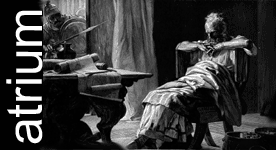From ANSA:
Four frescoed rooms in Augustus's House on Rome's Palatine Hill are to open to the public for the first time this weekend.
Experts believe the rooms, found in the 1970s below the ruins of Augustus's sprawling imperial palace, were part of a smaller house where he lived when he was still just Julius Caesar's adoptive son Octavian and not Rome's first emperor.
The four surviving rooms from the two-storey house are a dining room, a bedroom and a large entrance hall on the ground floor, and a small study on the floor above.
The windowless rooms received light from the entrance, which once looked out onto extensive gardens but is now blocked off by a wall dating to the reign of Nero (37-68 AD).
Fragments of the rooms' frescoes found by archaeologists on the floor have been painstakingly pieced back together during a 1.5-mln-euro restoration of the house.
Experts say the frescoes are among the most splendid surviving examples of Roman wall painting, on a par with those currently housed in the National Museum of Rome at Palazzo Massimo and those found in the house of Augustus's wife Livia.
Guided tours of the house will be covered by a new single ticket offering access to the Roman Forums, the Colosseum and the Palatine.
But only five people at a time will be allowed in to see the rooms due to their small dimensions and the fragility of the frescoes.
Augustus's House has been revealing new finds for years, although most of the digs are off-limits to visitors.
In November last year archaeologists said they had found a grotto deep beneath the palace which they argue may have been the shrine where Ancient Romans worshipped Romulus, the founder of the city.
Next year archaeologists hope to open to the public Augustus's resting place - a once majestic mausoleum in white travertine marble that is now an overgrown ruin in one of Rome's Fascist-era piazzas.
Augustus, the first emperor of Rome and the architect of the famed 'pax romana' ('Roman peace'), began building the mausoleum in 28BC after seeing the mausoleum of Alexander the Great in Egypt.
He was entombed in his creation in AD 14, and after him many other emperors and their loved ones were buried in niches of the building. A 20-mln-euro project is under way to restore the ruin and to redesign the square in which it stands.
